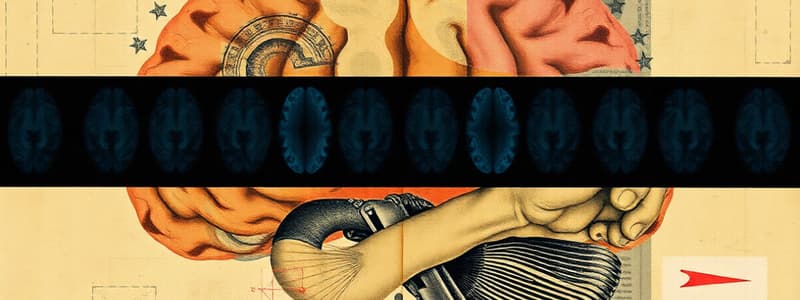Podcast
Questions and Answers
What is the goal of reverse inferences in cognitive neuroscience?
What is the goal of reverse inferences in cognitive neuroscience?
- To identify the brain structure responsible for a specific cognitive function
- To compare brain activity between different cognitive tasks
- To infer a cognitive function from observed brain activity patterns (correct)
- To assess the overarching mental processes in psychological disorders
Which of the following best describes non-reductive physicalism?
Which of the following best describes non-reductive physicalism?
- Only physical states are necessary to understand cognitive processes.
- Mental states can be fully explained through physical states.
- Mental and physical states are related but distinct from each other. (correct)
- Mental and physical states are completely interchangeable.
What does a structural MRI primarily measure?
What does a structural MRI primarily measure?
- Neural electrical activity in real-time
- Changes in blood flow related to brain function
- Brain activity during cognitive tasks
- The physical structure and anatomy of the brain (correct)
Which technique is specifically used to assess changes in blood flow to indicate brain activity?
Which technique is specifically used to assess changes in blood flow to indicate brain activity?
What is the primary difference between structural imaging and functional imaging?
What is the primary difference between structural imaging and functional imaging?
Which cognitive function is associated with the N400 brain pattern?
Which cognitive function is associated with the N400 brain pattern?
What is a common limitation of using only one neuroimaging technique for studying brain functions?
What is a common limitation of using only one neuroimaging technique for studying brain functions?
How can the assumption of one-to-one mapping in cognitive neuroscience be problematic?
How can the assumption of one-to-one mapping in cognitive neuroscience be problematic?
What does fractional anisotropy measure in the context of water diffusion in nerve fibres?
What does fractional anisotropy measure in the context of water diffusion in nerve fibres?
Which imaging technique is used primarily for visualizing cerebral blood flow?
Which imaging technique is used primarily for visualizing cerebral blood flow?
What is a major disadvantage of positron emission tomography (PET)?
What is a major disadvantage of positron emission tomography (PET)?
What physiological change is functional imaging based on?
What physiological change is functional imaging based on?
How do neurons obtain the oxygen and glucose they need for energy?
How do neurons obtain the oxygen and glucose they need for energy?
What happens to blood oxygenation levels immediately after neuronal activity increases?
What happens to blood oxygenation levels immediately after neuronal activity increases?
Which option describes a limitation of functional MRI (fMRI)?
Which option describes a limitation of functional MRI (fMRI)?
What is the primary function of diffusion weighted imaging (DWI)?
What is the primary function of diffusion weighted imaging (DWI)?
What phenomenon occurs during positron emission decay in PET imaging?
What phenomenon occurs during positron emission decay in PET imaging?
Which statement is true regarding structural versus functional imaging techniques?
Which statement is true regarding structural versus functional imaging techniques?
What is the primary purpose of structural imaging techniques?
What is the primary purpose of structural imaging techniques?
What are the types of structural imaging mentioned?
What are the types of structural imaging mentioned?
Which imaging technique provides better contrast between grey matter and white matter?
Which imaging technique provides better contrast between grey matter and white matter?
In MRI, what does the term 'Larmor frequency' refer to?
In MRI, what does the term 'Larmor frequency' refer to?
What happens during the dephasing process in MRI?
What happens during the dephasing process in MRI?
What is the significance of having an odd number of protons in a nucleus for MRI?
What is the significance of having an odd number of protons in a nucleus for MRI?
Which of the following statements correctly differentiates between structural and functional imaging?
Which of the following statements correctly differentiates between structural and functional imaging?
What do T2-weighted images in MRI primarily highlight?
What do T2-weighted images in MRI primarily highlight?
Flashcards are hidden until you start studying
Study Notes
Cognitive Neuroscience
- Assumes a one-to-one mapping between brain patterns and cognitive functions
Types of Inferences
- Forward inferences: Using different brain activity patterns to compare cognitive theories
- Reverse inferences: Inferring cognitive functions from brain patterns
One-to-one Mapping
- Assumes that one cognitive function corresponds to one specific brain pattern, and vice versa
- This is not a guaranteed assumption, especially considering reductive physicalism, which suggests mental processes can be reduced to physical states
Structural and Functional Imaging
- Structural imaging focuses on the brain's anatomy, providing detailed, static images
- Functional imaging investigates brain function, tracking physiological changes
Haemodynamic Methods
- These methods rely on the dynamics of blood flow in the brain
- Functional imaging depends on the brain's blood supply for neural activity
- Neuronal activity requires oxygen and glucose, supplied by blood entering the brain through arteries.
- Oxygen molecules are removed from haemoglobin, resulting in deoxyhaemoglobin.
- Increased energy consumption leads to a decrease in blood oxygenation.
Positron Emission Tomography (PET)
-
In vivo imaging technique for biological, physiological, and biochemical processes
-
Radioactive tracers are injected into the body, attached to molecules with specific biological actions
-
Tracers have a short half-life, transforming into non-radioactive forms through positron emission decay.
-
The emitted positrons annihilate with electrons, creating photons that travel in opposite directions.
-
Gamma rays are released during annihilation, with more blood flow resulting in more gamma rays.
-
Coincidence detection of these gamma rays is used to reconstruct an image.
-
Regions with abnormal deposition and metabolism are visualized as an intensity map.
-
Negatives of PET:*
-
Poor structural image resolution (lower spatial resolution).
-
Short tracer half-life can be challenging.
-
Small risk of radiation exposure.
Functional Magnetic Resonance Imaging (fMRI)
- Relies on blood oxygen level-dependent (BOLD) contrast to measure neural activity.
- Measures the changes in blood flow resulting from neuronal activity.
- Increased neuronal activity leads to increased blood flow and oxygenation, detectable by fMRI.
Structural MRI
- Provides clear and precise images of neuroanatomical structures.
- Used to detect abnormal anatomy.
- Produces T1-weighted (T1W) and T2-weighted (T2W) images.
- T1W images show good contrast between grey and white matter, and cerebrospinal fluid (CSF).
- T2W images contrast CSF (bright) and brain matter (dark).
How MRI Works
- Based on nuclear magnetic resonance (NMR) principles.
- Protons and neutrons have a quantum mechanical property called spin.
- Odd numbers of protons or neutrons lead to a non-zero magnetic momentum.
- Magnetic fields cause the magnetic momentum to align with the field.
- Nuclei with odd spin resonate at a specific frequency (Larmor frequency).
- Radiofrequency (RF) pulses are used to excite the nuclei and align their spins.
- When the RF pulse is removed, the nuclei return to their original state, emitting RF signals.
- These signals are detected and used to create an image.
Diffusion Weighted Imaging (DWI)
- Visualizes early pathological changes in tumors, strokes, and cancers.
- Measures the rate of diffusion of water molecules.
- Higher diffusion rates indicate damage, where water diffuses more freely.
Arterial Spin Labeling (ASL), aka Perfusion Weighted Imaging (PWI)
- Visualizes tissue perfusion and cerebral blood flow.
- MRI machines use RF pulses to magnetize water molecules in blood, allowing perfusion measurement.
Strengths and Weaknesses of Structural Techniques
- Strengths: High spatial resolution, good for visualizing anatomical structures
- Weaknesses: Static images, do not provide information on function
Diffusion Tensor Imaging (DTI)
- Measures the diffusion of water molecules in different directions.
- Helps track white matter pathways.
- Measures Fractional Anisotropy (FA), a value between 0 (random diffusion) and 1 (directional diffusion).
- High FA values indicate more organized white matter pathways.
Magnetoencephalography (MEG)
- Measures magnetic fields produced by electrical activity in the brain.
- Provides excellent temporal resolution but limited spatial resolution.
- Used to study a wide range of brain function, such as language, cognition, and sensory processing.
Electroencephalography (EEG)
- Measures electrical activity in the brain using electrodes placed on the scalp.
- Provides excellent temporal resolution but limited spatial resolution.
- Used to study sleep, epilepsy, and other brain states.
- Less expensive than fMRI.
Functional Near-Infrared Spectroscopy (fNIRS)
- Measures changes in blood oxygenation in the brain using near-infrared light.
- Offers good portability and relatively low cost compared to fMRI.
- Limited spatial resolution to the surface of the brain.
Transcranial Magnetic Stimulation (TMS)
- Uses magnetic pulses to stimulate or inhibit specific brain regions.
- Helps investigate the causal role of different brain areas in cognitive functions.
- Non-invasive and safe.
Choosing an Appropriate Technique
- Consider the research question, the desired spatial and temporal resolution, and cost-effectiveness.
- For example, if a study aims to assess the brain regions involved in processing the meaning of words, fMRI would be an appropriate choice.
- If the study is focused on the precise timing of brain activity, EEG or MEG would be better suited.
Studying That Suits You
Use AI to generate personalized quizzes and flashcards to suit your learning preferences.





